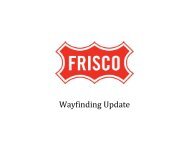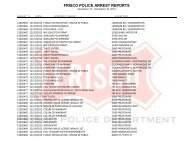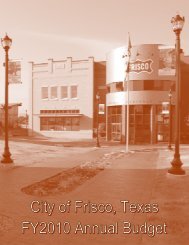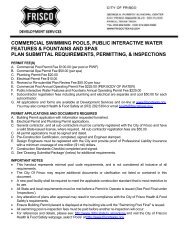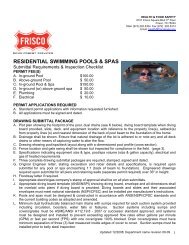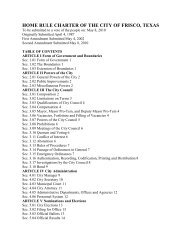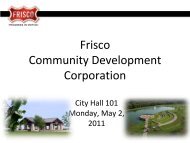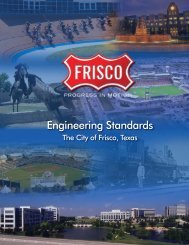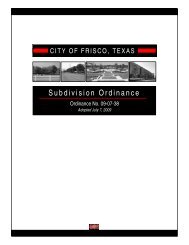Modern Roundabout Feasibility Study - City of Frisco
Modern Roundabout Feasibility Study - City of Frisco
Modern Roundabout Feasibility Study - City of Frisco
You also want an ePaper? Increase the reach of your titles
YUMPU automatically turns print PDFs into web optimized ePapers that Google loves.
OHIO DRIVE ROUNDABOUT FEASIBILITY STUDY, CITY OF FRISCO<br />
4.0 CONCEPTUAL ROUNDABOUT DESIGN<br />
Figure 9 provides a review <strong>of</strong> the basic geometric features and key dimensions <strong>of</strong> a roundabout.<br />
4.1 <strong>Roundabout</strong> Design Criteria<br />
The conceptual roundabout layout designs were developed primarily by the following guidelines:<br />
<strong>Roundabout</strong>s: An Informational Guide 2 nd Edition (2010) – FHWA NCHRP #672<br />
Roadway Design Manual (May 2010) - TxDOT<br />
A Policy on Geometric Design <strong>of</strong> Highways and Streets (2004) – AASHTO<br />
Table 6 is a summary <strong>of</strong> the design criteria used for the proposed roundabout concepts. Under<br />
the two-lane roundabout concepts for Gaylord Parkway and Warren Parkway, each movement<br />
will include two lanes through the roundabout as well as on the entries and exits <strong>of</strong> the<br />
roundabout. However, the eastbound departures will only provide a single lane exit. Under the<br />
partial two-lane roundabout concept for Prestmont Place, the minor east-west movements will<br />
provide a single lane approach to the roundabout. The approaches to the roundabout were<br />
designed with a left-<strong>of</strong>fset, which improves the vehicle deflection at the roundabout entries.<br />
Table 6 - Summary <strong>of</strong> <strong>Roundabout</strong> Design Criteria<br />
Criteria<br />
Design Vehicle<br />
Inscribed Diameter<br />
Entry Design Speed<br />
Circulatory Roadway Width<br />
Truck Apron Width<br />
WB-50 Truck<br />
150 feet<br />
30 mph (35 mph max)<br />
28 feet (Two Lanes)<br />
10 feet<br />
Source: FHWA <strong>Roundabout</strong>s: An Informational Guide 2 nd Edition<br />
Figure 9 - Basic Geometric Elements <strong>of</strong> a <strong>Roundabout</strong><br />
While the design vehicle was a WB-50 truck, the roundabout design was also checked for the<br />
<strong>City</strong>’s largest fire engine, to ensure that the fire engine would be able to navigate around the<br />
roundabout even with a car blocking one <strong>of</strong> the lanes. In addition, to make the design fire engine<br />
friendly, the truck apron will likely be a textured concrete surface <strong>of</strong> a different color but flush<br />
with the circulatory roadway pavement, such that the fire engine will be able to navigate over the<br />
truck apron without a bump. Section 4.5 shows illustrations <strong>of</strong> the WB-50 truck and fire engine<br />
turning wheel paths for the critical turns around the roundabouts.<br />
The design <strong>of</strong> a roundabout allows pedestrians to cross one direction <strong>of</strong> traffic at a time on each<br />
leg <strong>of</strong> the roundabout. Pedestrians can expect an approaching vehicle from one direction, rather<br />
than multiple directions such as a left-turn, right-turn, or through movement. The crosswalks are<br />
set back approximately 20 feet from the yield line, which is enough space for one vehicle to store<br />
prior to entering the roundabout. This encourages the driver behind the entering vehicle to focus<br />
on crossing pedestrians. These safety benefits are also applicable to bicyclists. Depending on<br />
their skill level, cyclists may enter the roundabout with a decision process that mirrors the<br />
operation <strong>of</strong> motorized vehicles. The lower speed environment within the roundabout would<br />
provide more time for all users to detect and correct for their mistakes or the mistakes <strong>of</strong> others.<br />
BROWN & GAY ENGINEERS, INC.<br />
8



